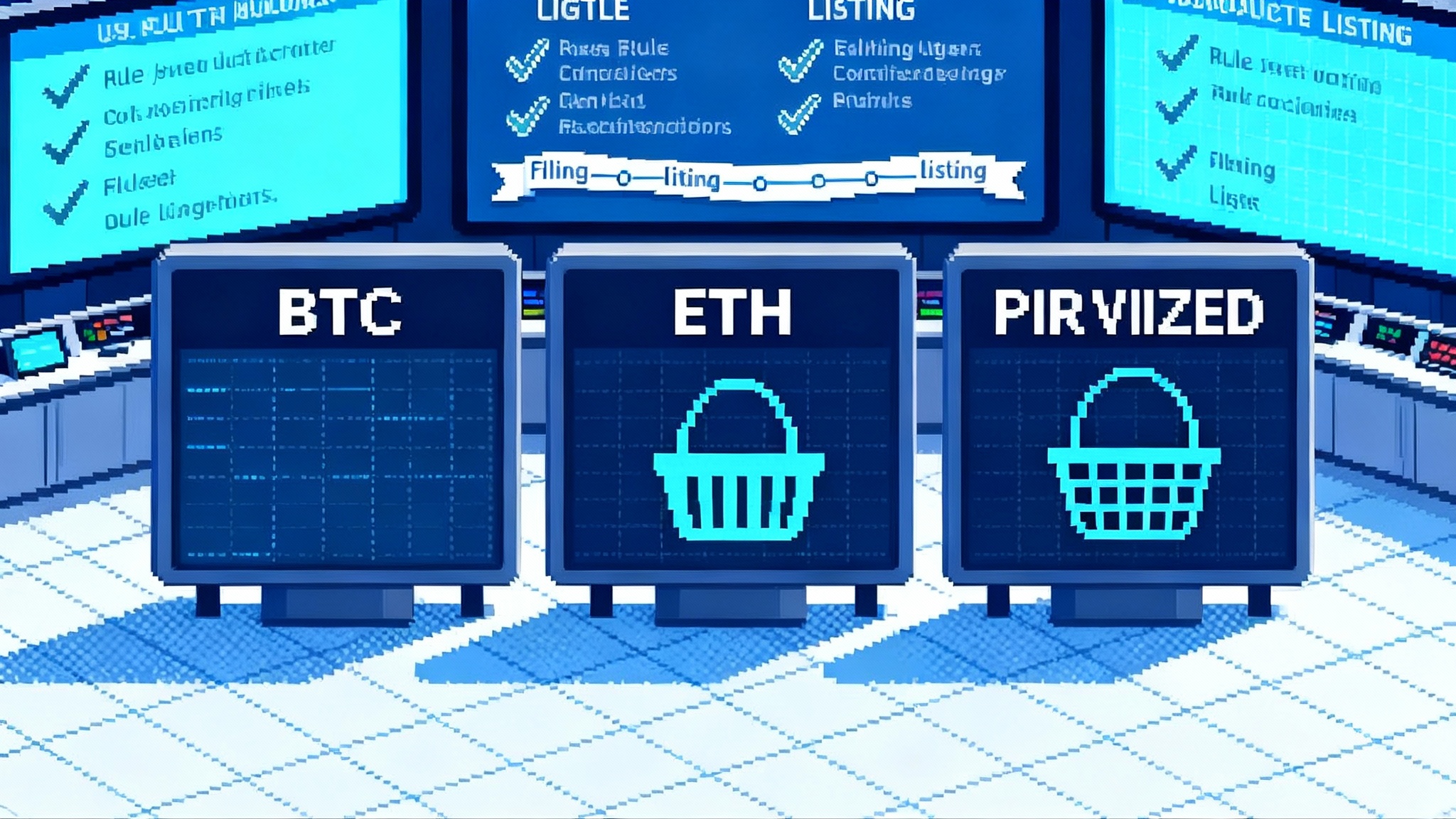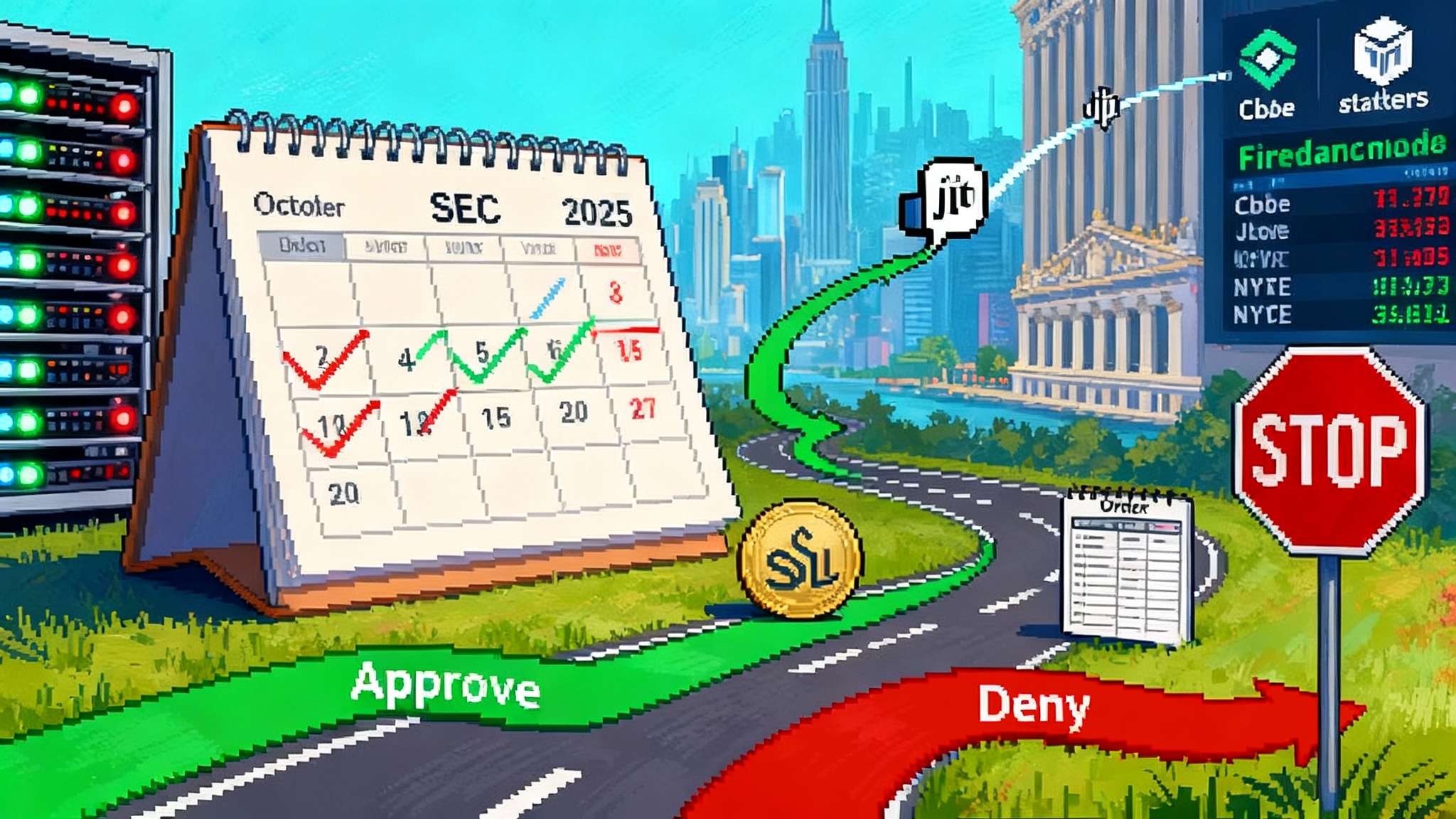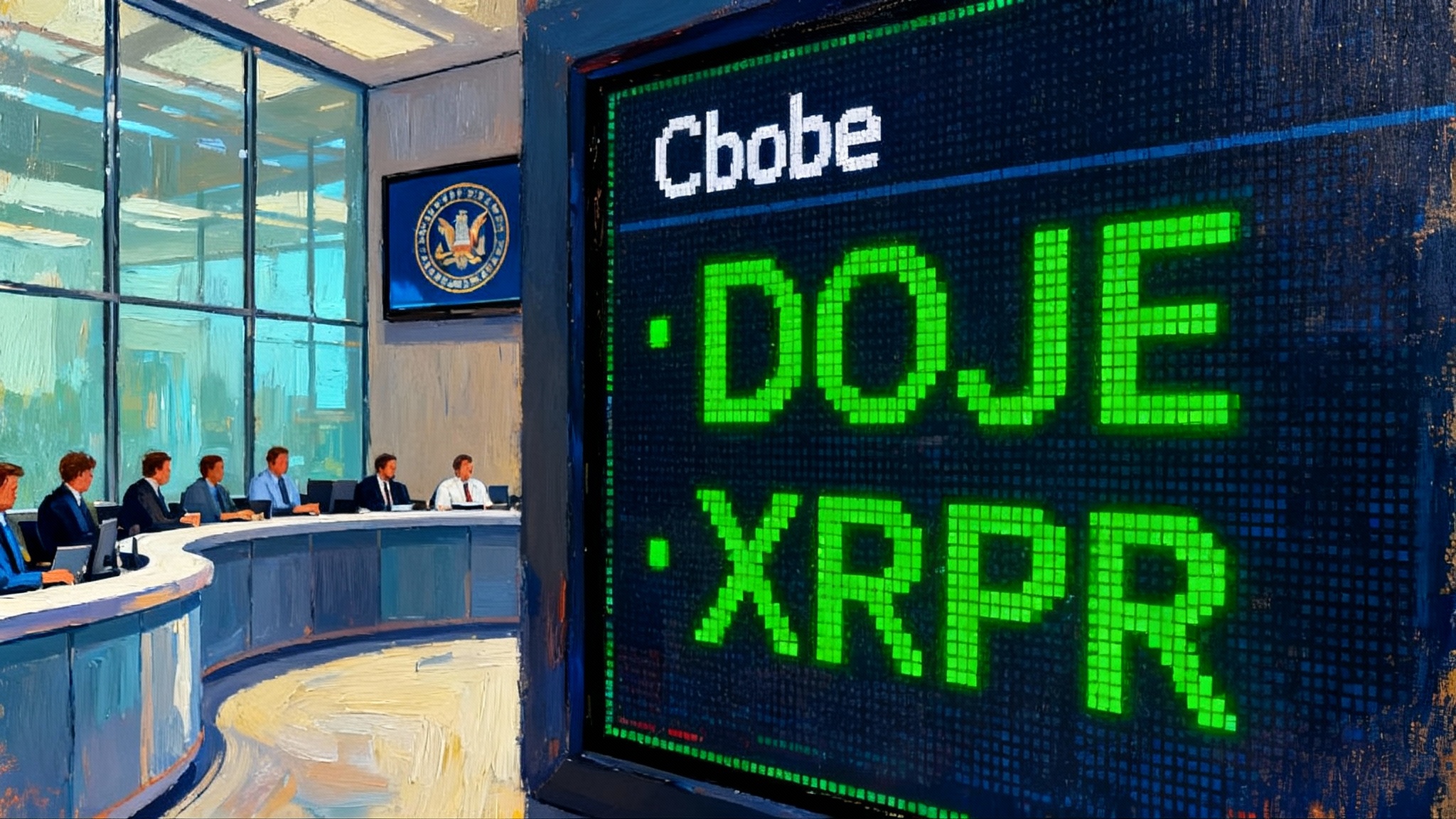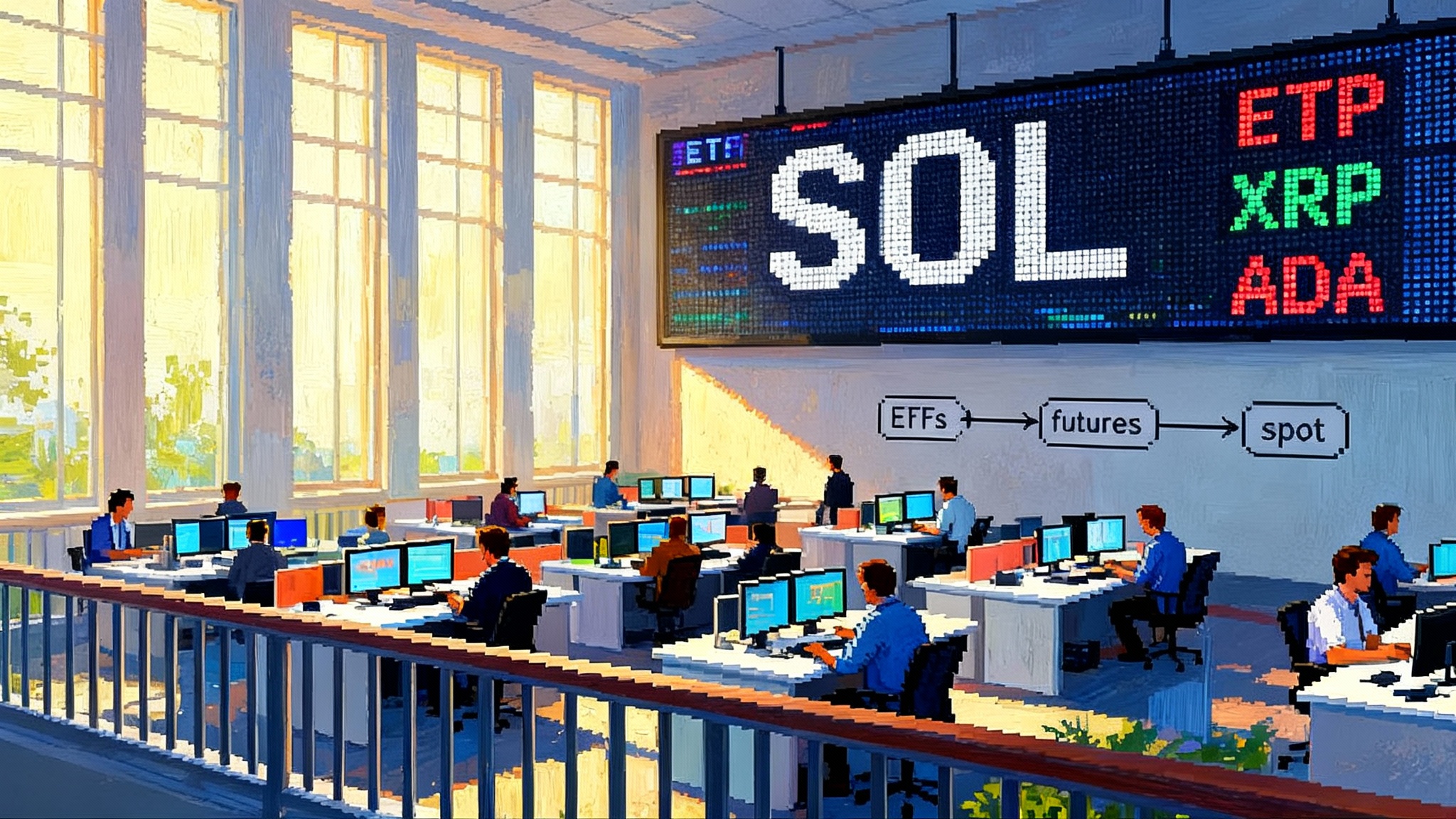ETF Floodgate Moment: SEC’s generic rules reset crypto
The SEC just cleared generic listing standards so NYSE, Nasdaq, and Cboe can list spot crypto ETPs without bespoke 19b-4 approvals. Here is what changed, which tokens qualify first, and how in-kind creations will reshape spreads, liquidity, and costs.

What actually changed
The SEC approved exchange rule changes that let NYSE Arca, Nasdaq, and Cboe BZX list spot commodity ETPs, including crypto, under generic listing standards instead of one-off 19b-4 approvals. In short, if a product fits the pre-set criteria, an exchange can list it without waiting for a custom order. The approval covers Commodity-Based Trust Shares that hold spot assets and outlines how issuers, custodians, market makers, and exchanges must operate. Read the SEC order approving generic standards for the full scope. For more context, see our spot ETF floodgates analysis.
This is the long-awaited floodgate moment. It replaces a bespoke, two-track gauntlet with a predictable, rules-based on-ramp.
The new eligibility test, decoded
Under the generic standards, each commodity a trust holds must meet at least one of three routes to eligibility:
- It trades on a market that is a member of the Intermarket Surveillance Group, and the listing exchange can obtain trading information from that member.
- It underlies a futures contract that has traded for at least six months on a CFTC-regulated designated contract market, and the listing exchange has a surveillance sharing agreement with that DCM.
- On an initial basis only, there is already an exchange-traded fund with at least 40% of its net assets in that commodity that lists on a national securities exchange.
In practice, the second route will do most of the work for digital assets. Where a token has an established, regulated U.S. futures market with sufficient history, a spot ETP that holds that token can be listed generically once operational and disclosure requirements are met.
The order also bakes in market structure guardrails. Exchanges must be able to halt trading if the intraday indicative value or reference pricing stops printing. Issuers must publish NAV daily and maintain clear liquidity risk policies. Registered market makers face added recordkeeping and information-barrier obligations. These are standard ETF plumbing, now extended to crypto trusts.
Why this breaks from the Bitcoin and Ether era
Before this vote, every spot crypto ETP required both an exchange rule change under Section 19(b) and an effective registration statement. The first step often stretched 240 days. Now, for products that meet the generic standards, the exchange can list on a predictable timeline after the registration is effective.
There is a second critical change in the background. In late July, the SEC permitted in-kind creations and redemptions for crypto ETPs. That moves authorized participant workflows closer to the commodity ETP norm and removes frictions seen in early spot bitcoin and ether launches. See the SEC notice permitting in-kind processes. For a deeper dive on design choices, read multi-asset ETFs and in-kind flows.
Together, generic listing plus in-kind AP activity remove two structural choke points that kept crypto products expensive, slow to launch, and operationally clunky.
Who is first in line
Short answer: tokens with established, regulated U.S. futures markets that have traded for at least six months. As of mid-September 2025, that puts Solana at the front of the queue, subject to each exchange’s surveillance agreements and the product’s registration going effective. XRP appears close behind once the six-month futures trading clock is satisfied later in Q4 2025. For timelines and scenarios, see Solana ETF decision in October.
Multi-asset funds are already viable. A large-cap basket structured as a commodity trust can list if the underlying components collectively satisfy the eligibility routes or if the Commission has specifically approved the product. Expect issuers to lean on diversified indices to reach market quickly while single-asset products line up behind the futures-history requirement.
What about other names? The same playbook applies. If a token develops a regulated DCM futures market with real liquidity and clears the six-month test, it moves into the generic lane. Without that futures footprint, it will not qualify under the new generic standards unless it is part of a product approved outside the generic path.
In-kind creations will rewire flows, spreads, and costs
Allowing APs to deliver and receive the token rather than cash does three big things:
-
It compresses primary market frictions. In cash-create models, APs wire dollars, issuers or agents source the token, and spreads must cover execution costs, slippage, and custody moves. In-kind shifts price discovery and inventory management back to APs and market makers who trade the asset every day. That tends to tighten the creation basket mark, which narrows ETF bid-ask spreads over time.
-
It moves real liquidity on-chain. Primary market activity now triggers direct token transfers between AP wallets and the trust’s custodian. During net creations, liquidity providers will source tokens across centralized venues and on-chain DEXs, then settle to the custodian. That raises the importance of robust settlement rails, token transfer throughput, and reliable deposit mechanics at the custodian.
-
It reduces hedging bleed. With cash creates, APs often pre-hedge with futures or perpetuals and unwind after the issuer completes spot buys. In-kind allows APs to contribute existing inventory or assemble baskets in the most efficient venue, cutting basis risk and financing costs. That can shave ongoing ETF expense leakage that would otherwise show up as tracking drag.
Net effect: tighter spreads, lower tracking error, and a deeper linkage between ETF primary flows and on-chain liquidity in the underlying networks.
Index construction will steer on-chain liquidity
Issuers launching under generic standards have every incentive to start with index-tracking products. Indexes set rules for eligibility, weighting, rebalancing, and constituent changes. Those choices will shape real token flows:
- Weighting concentration: Market cap weightings concentrate flows in the top two or three assets. If a token is 3% of an index, it gets 3% of net creations.
- Rebalancing cadence: Quarterly or monthly index rebalances create predictable buy and sell waves. On-chain AMMs and OTC desks will position to warehouse risk into those windows. Expect occasional spikes in gas or priority fees on some networks.
- Eligibility screens: Index providers often require certain custody and price-formation standards. Tokens that lack qualified custodial support, robust reference rates, or free-float clarity will struggle to be included, even if they clear the SEC’s generic test.
For teams, landing in the right indices may move the needle more than short-term headlines. For market makers, index calendars become core scheduling data alongside earnings seasons and macro prints.
Custody and staking under the 85% rule
The generic standards require liquidity risk policies that keep at least 85% of trust assets available to meet redemptions within one business day. That constraint is simple but powerful for crypto ETP design:
- Staking: If staking a token would lock or encumber more than 15% of assets, the trust risks breaching its policy. That limits aggressive staking yields in ETPs and reduces the allure of staking-enhanced share classes.
- Wallet architecture: Cold storage remains the baseline, but issuers will need operational hot or warm pathways sized to handle creation and redemption surges without settlement delays.
- Qualified custodians: Demand rises for custodians that can demonstrate operational resilience, SOC audits, insurance frameworks, and seamless large-lot settlement across multiple networks. Expect concentration around a handful of providers at launch, with second-tier entrants competing on fees and API quality.
This also influences spreads. If a custodian’s deposit or withdrawal cycles are slow, APs widen quotes to reflect settlement risk. Issuers that invest in fast, predictable custody workflows can win tighter primary markets and better secondary-market behavior.
Market microstructure: what tightens and what does not
- Spreads: With in-kind, creation baskets should price closer to true mid. Combined with more APs willing to run inventory, expect narrower ETF spreads over time, especially in U.S. trading hours.
- Basis and futures links: Where regulated futures exist, the ETF becomes a new leg in cash-and-carry trades. That improves price alignment between ETF shares, spot tokens, and DCM futures, reducing sustained basis anomalies.
- Cross-market surveillance: The standards lean on information sharing with DCMs and other markets. That supports better detection of manipulative patterns and reduces the probability of prolonged dislocations around opens and closes.
- Halts: ETFs will still halt if reference values or NAVs stop printing. Crypto’s fragmented price formation means these events will happen, but with more redundancy in benchmarks and IIV dissemination they should be shorter and less frequent than in the early spot bitcoin days.
What this means for tokens beyond BTC and ETH
Three practical tiers emerge:
- Near-term generics: Assets with a six-month record on a U.S. DCM and robust spot liquidity. Solana fits this profile now. XRP is expected to enter this bucket later in Q4 2025 once the futures tenure milestone is met.
- Index passengers: Assets with solid custody and pricing that join diversified baskets by virtue of index methodology and explicit product approvals. These tokens get exposure to net creations without meeting the single-asset generic test yet.
- Not yet: Assets without DCM futures and without strong custody or reference pricing will wait. They may appear in offshore products, but they will not qualify under the U.S. generic route until the futures market arrives and seasons.
The competitive map for issuers and exchanges
Generic standards shift competition to speed, fees, and brand. Expect:
- Fee compression: With faster paths to market and more look-alike products, management fees should trend down as scale players with distribution price aggressively.
- Shelf variety: Thematic mixes, duration-targeted baskets, and wrappers that combine crypto with gold or other commodities are in play as long as each holding passes eligibility and disclosure tests.
- Options and leverage: As liquidity builds, listed options on crypto ETPs and index variants will expand, deepening hedging tools for APs and market makers and adding new investor strategies.
A 90-day roadmap
For projects and token teams
- Week 1-2: Checklist eligibility. Confirm price benchmarks, custody readiness, and operational throughput for large creates. If your token has DCM futures, document six-month tenure and market health.
- Week 3-4: Engage index providers. Map where your token sits in large-cap indices. Share float, supply, and custody coverage data that supports inclusion.
- Week 5-8: Run settlement drills with target custodians. Test high-volume deposits and withdrawals, chain congestion contingencies, and address-whitelisting workflows. Publish operational transparency dashboards for institutions.
- Week 9-12: Build an ETF-aware market-making program. Encourage deeper borrow and inventory across centralized venues and on-chain pools timed to index rebalances and U.S. ETF opens.
For investors and trading desks
- Week 1-2: Update playbooks. Incorporate the generic eligibility routes into your calendar. Track futures tenure dates for candidate tokens and S-1 effective dates.
- Week 3-6: Prepare capital and pipes for in-kind. Coordinate with APs and custodians to enable token delivery. Stress-test fails and collateral haircuts for settlement delays.
- Week 7-10: Model tracking and basis. For each new product, map the arbitrage triangle between ETF, spot, and DCM futures. Set thresholds for when to run creations versus secondary-market buys.
- Week 11-12: Align risk. Set hard rules for halts, IIV outages, and rebalances. Decide how to treat staking or airdrop events inside trusts for PnL and tax.
For regulators and exchanges
- Week 1-3: Finalize surveillance sharing. Ensure CSSAs with relevant DCMs are live and operational. Test alerting for cross-market manipulation patterns.
- Week 4-8: Publish issuer guidance. Clarify expectations on liquidity risk policies, staking limits, forks, and airdrops. Provide templates for website disclosures and IIV requirements.
- Week 9-12: Monitor and report. Share early data on spreads, halts, and primary market behavior. Use findings to refine continued listing standards and market maker obligations where needed.
The bottom line
This is the moment crypto’s ETF market grows beyond two tickers. The SEC’s generic standards turn a bespoke approval process into a rules-based system that commodity ETPs have enjoyed for years. Pair that with in-kind creations and you get a cleaner, cheaper primary market and tighter ETF spreads. The winners will be tokens with regulated futures footprints, issuers that execute clean operations from custody to AP logistics, and regulators who use cross-market data to keep the pipes running smoothly. For ongoing coverage, check our altcoin ETF rules explainer.
For investors, the play is simple: watch the futures tenure calendar, track registration statements, and price liquidity. The floodgate is open. Now the water has to flow through well-built channels.








